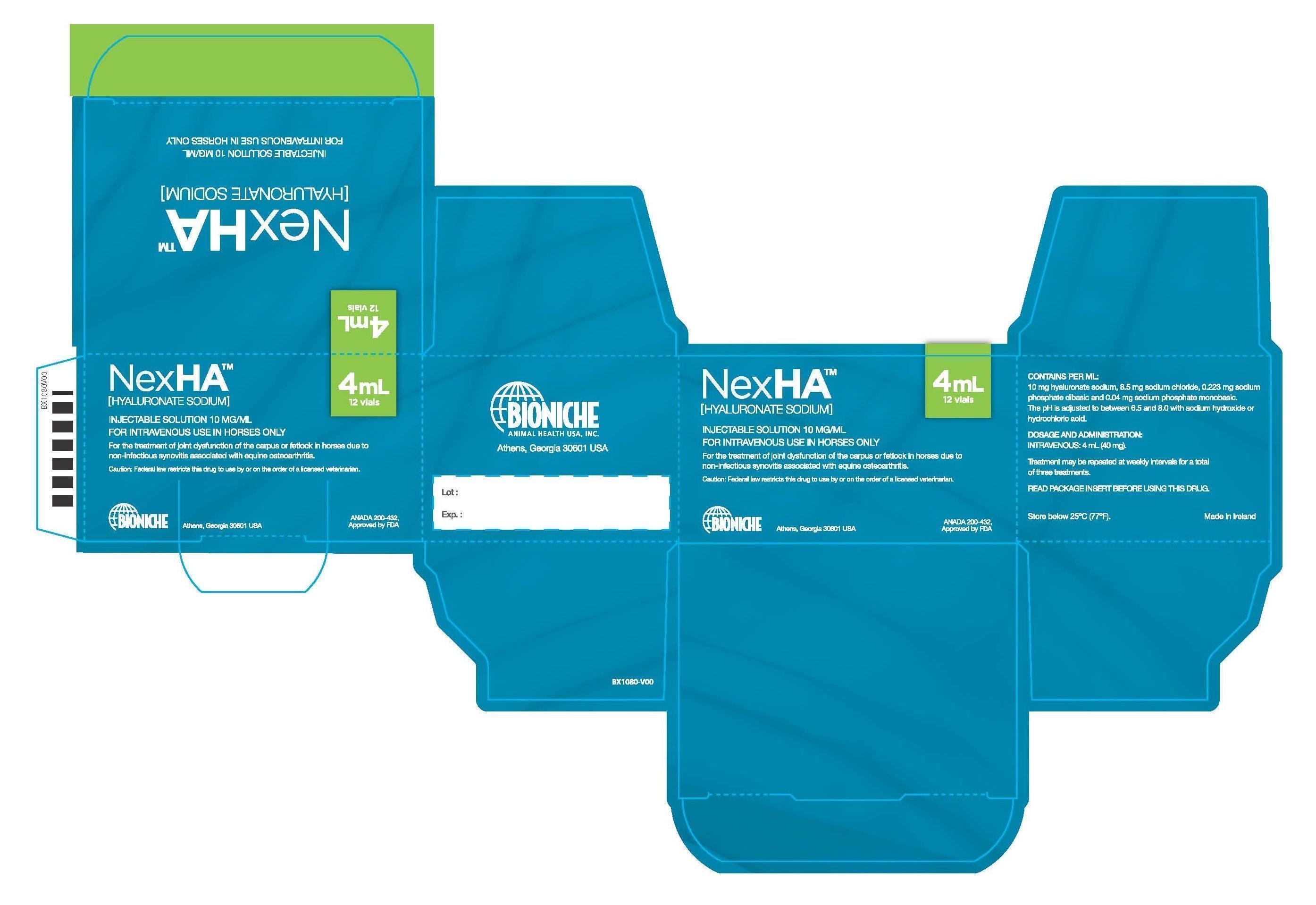NEXHA- hyaluronate sodium injection, solution
NexHA by
Drug Labeling and Warnings
NexHA by is a Animal medication manufactured, distributed, or labeled by Bioniche Animal Health USA, Inc., Vetoquinol USA, Inc., Bioniche Animal Health Canada Inc., Lifecore Biomedical LLC, Mylan Teoranta. Drug facts, warnings, and ingredients follow.
Drug Details [pdf]
- CAUTION:
-
DESCRIPTION:
NexHATM (hyaluronate sodium) injectable solution is a clear, colorless solution of low viscosity. NexHATM injectable solution is pyrogen free, sterile and does not contain a preservative. It is administered by intravenous injection. Hyaluronic acid, the conjugate acid of hyaluronate sodium, is extracted from the capsule of Streptococcus spp. and purified, resulting in a form which is essentially free of protein and nucleic acids. NexHATM injectable solution is supplied in 4 mL (40 mg) vials.
Each mL contains 10 mg hyaluronate sodium, 8.5 mg sodium chloride, 0.223 mg sodium phosphate dibasic and 0.04 mg sodium phosphate monobasic. The pH is adjusted to between 6.5 and 8.0 with sodium hydroxide or hydrochloric acid. -
CHEMISTRY:
Hyaluronic acid, a glycosaminoglycan, can exist in the following forms depending upon the chemical environment in which it is found: as the acid, hyaluronic acid; as the sodium salt, sodium hyaluronate (hyaluronate sodium); or as the hyaluronate anion. These terms may be used interchangeably but in all cases, reference is made to the glycosaminoglycan composed of repeating subunits of D-glucuronic acid and N-acetyl-Dglucosamine linked together by glycosidic bonds. Since this product originates from a microbial source, there is no potential for contamination with dermatan or chondroitin sulfate or any other glycosaminoglycan.
-
CLINICAL PHARMACOLOGY:
Hyaluronic acid is a naturally occurring substance present in connective tissue, skin, vitreous humor and the umbilical cord in all mammals. High concentrations of hyaluronic acid are also found in the synovial fluid. It also constitutes the major component of the capsule of certain microorganisms. The hyaluronic acid produced by bacteria is the same structure and configuration as that found in mammals.
The actual mechanism of action for hyaluronate sodium in the healing of degenerative joint disease is not completely understood. One major function appears to be the regulation of normal cellular constituents. This effect decreases the impact of exudation, enzyme release and subsequent degradation of joint integrity. Additionally, hyaluronate sodium exerts an anti-inflammatory action by inhibiting the movement of granulocytes and macrophages.1
Hyaluronate molecules are long chains which form a filter network interspersed with normal cellular fluids. It is widely accepted that injection directly into the joint pouch enhances the healing of inflamed synovium by restoring lubrication of the joint fluid. This further supplements the visco-elastic properties of normal joint fluid.
- INDICATIONS:
-
DOSAGE AND ADMINISTRATION:
4 mL (40 mg) injected intravenously. Treatment may be repeated at weekly intervals for a total of three treatments. Use aseptic technique and inject slowly into the jugular vein. Horses should be given stall rest after treatment before gradually resuming normal activity.
Discard any unused portion of the drug and the empty vial after opening.
- CONTRAINDICATIONS:
- WARNING:
- HUMAN WARNINGS:
- ANIMAL SAFETY WARNING:
- PRECAUTIONS:
- ADVERSE REACTIONS:
- POST-APPROVAL EXPERIENCE:
-
EFFECTIVENESS:
Forty-six horses with lameness in either the carpal or fetlock joints were treated intravenously or intra-articularly with hyaluronate sodium injectable solution in a well controlled clinical field trial conducted at four locations. One, two or three injections were given based on clinical improvement. Overall clinical improvement was judged as excellent or good in 90% of the cases treated intravenously and 96% of those treated intra-articularly with hyaluronate sodium injectable solution.
-
ANIMAL SAFETY:
Hyaluronate sodium injectable solution was administered to normal horses at one, three and five times the recommended intra-articular dosage of 20 mg and the intravenous dosage of 40 mg. Treatments were given once weekly for nine consecutive weeks (three times the maximum duration). No systemic clinical signs were observed nor were there any adverse effects upon hematology or clinical chemistry parameters. A transient, slight to mild post-injection swelling of the joint capsule occurred in some of the animals treated intra-articularly with hyaluronate sodium injectable solution as it did in the saline treated control horses. No gross or histological lesions were observed in the soft tissues or the surface areas of the treated joint.
- STORAGE:
- HOW SUPPLIED:
-
REFERENCES:
1 Swanstrom, O.G. 1978. Hyaluronate (hyaluronic acid) and its use, Proc. American Assoc. Equine Pract., 24th annual convention, pp. 345-348.
For customer service or to obtain product information, including a Material Safety Data Sheet, call:1-706-549-4503. After hours, call 1-706-353-2442 or 1-706-714-7373.
February 2011
ANADA 200-432, Approved by FDA
- Principal Display Panel
-
INGREDIENTS AND APPEARANCE
NEXHA
hyaluronate sodium injection, solutionProduct Information Product Type PRESCRIPTION ANIMAL DRUG Item Code (Source) NDC: 64847-804 Route of Administration INTRAVENOUS Active Ingredient/Active Moiety Ingredient Name Basis of Strength Strength HYALURONATE SODIUM (UNII: YSE9PPT4TH) (HYALURONIC ACID - UNII:S270N0TRQY) HYALURONATE SODIUM 10 mg in 1 mL Inactive Ingredients Ingredient Name Strength SODIUM CHLORIDE (UNII: 451W47IQ8X) 8.5 mg in 1 mL SODIUM PHOSPHATE, DIBASIC, DODECAHYDRATE (UNII: E1W4N241FO) 0.223 mg in 1 mL SODIUM PHOSPHATE, MONOBASIC, DIHYDRATE (UNII: 5QWK665956) 0.04 mg in 1 mL Packaging # Item Code Package Description Marketing Start Date Marketing End Date 1 NDC: 64847-804-12 12 in 1 CARTON 1 4 mL in 1 VIAL, SINGLE-USE Marketing Information Marketing Category Application Number or Monograph Citation Marketing Start Date Marketing End Date ANADA ANADA200432 11/19/2014 Labeler - Bioniche Animal Health USA, Inc. (361599173) Registrant - Vetoquinol USA, Inc. (106824209) Establishment Name Address ID/FEI Business Operations Bioniche Animal Health Canada Inc. 241811405 ANALYSIS, LABEL, PACK Establishment Name Address ID/FEI Business Operations Lifecore Biomedical LLC 085358869 API MANUFACTURE Establishment Name Address ID/FEI Business Operations Mylan Teoranta 986298925 ANALYSIS, MANUFACTURE, LABEL, PACK
Trademark Results [NexHA]
Mark Image Registration | Serial | Company Trademark Application Date |
|---|---|
 NEXHA 85084419 4580321 Live/Registered |
VETOQUINOL U.S.A. INC. 2010-07-14 |
© 2025 FDA.report
This site is not affiliated with or endorsed by the FDA.
